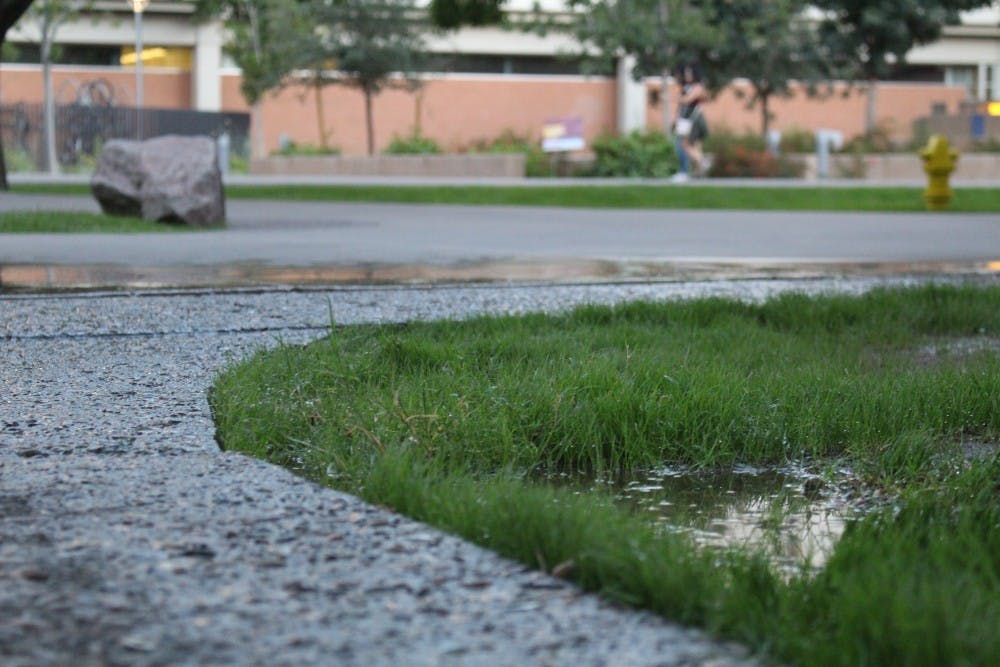With ASU recently finishing in the top five at the New Arizona Prize Water Innovation Challenge and in the top 10 in the Sierra Club’s cool schools list, the University has proven itself a hub for sustainability.
Between increased solar panels around campus and greener buildings, ASU has changed. But in the desert, one essential material is scarce: Water — and ASU uses a lot of it.
As a whole, ASU uses about 675 million gallons of water — no small amount — but the University serves nearly 100,000 people, according to figures provided by Sustainability Program Coordinator JoEllen Alberhasky. Of the 675 million gallons, 48 percent — around 324 million gallons — is used in domestic and sanitary purposes including bathrooms, laboratories and some of ASU’s dorms.
The next largest usage comes from the University's central water processing plant and Combined Heat and Power Facility. Each make up around 18 percent of ASU’s water use and approximately 36 percent of the campus drinking water. Finally, about 111 million gallons are used for irrigation.
ASU Director of Sustainability Michael Dalrymple said that while 48 percent is a hefty number for domestic water uses, it isn't abnormal.
“I believe that to be fairly typical, given our mixed building types and uses,” Dalrymple said. “It should definitely be lowered if we are to meet our 2020 goal of 50 percent reduction. We have started formulating plans for retrofitting older fixtures on campuses with newer, more water-efficient fixtures.”
Dalrymple also said that a lack of adequate resources and specific data on bathrooms poses a challenge when assessing reduction plans.
With no data on dorm room water usage, It isn't clear exactly how much water ASU students use in their dorms. And with no water cap, students can use as much as they please. However, Dalrymple said that caps wouldn't be a valid solution.
“Creating water limits is probably not a practical means to reduce water usage,” he said. “We want to focus on behavioral change. ASU professor emeritus Robert Cialdini is a pioneer in the field of behavior change psychology. Tools include creating teamwork, competition, social norms, association with luxury, public commitments, etcetera.”
ASU sustainability experts believe one of ASU’s more recent efforts, Waterworks, will bring down reliance on processing plants to make drinking water.
JoEllen Alberhasky said programs like Waterworks represent the long term goals the University has set for conservation.
“You want to try to match the type of water quality needed with the way you're going to use it, but at the same time, you want to make sure your uses with water are efficient.”
But with 83,000 students, water usage among the student body is also a consideration. Susan Norton, program coordinator of University sustainability practices, promoted the Strive for Five initiative, a program encouraging students to take faster showers.
“What we have been pushing is trying to reduce the shower times just because it is the easiest for students,” she said. “The best way to push that has been through education through our Strive for Five program in the residential halls. We have hourglass timers. We’ve given out the timers and we talk to students about water issues. We want them to really understand why it’s important.”
For the time being, improving ASU's water usages ironically hinges on available resources.
“With water, we’re not as far ahead as we’d like to be, but that's why we’re really working on it,” Norton said. “We can only do so much. We’re a team of five people. We have the largest student body of any school in the nation and our office team, we have five team members including our director. Water is something we decided we could do better.”
Reach the reporter at Emmillma@asu.edu or follow @Millmania1 on Twitter.
Like The State Press on Facebook and follow @statepress on Twitter.




